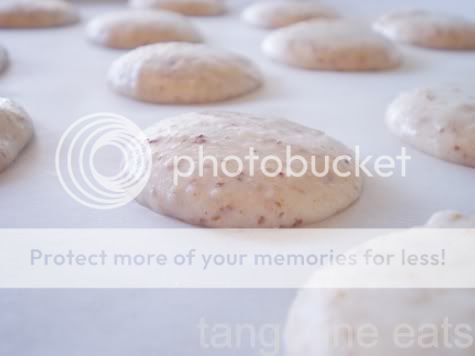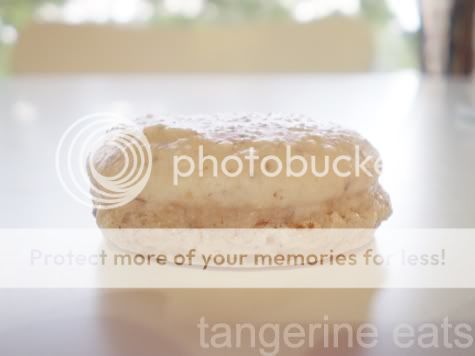They say that making macarons is an endeavour best left to the French. After several failed attempts, I realised that there is a lot of wisdom in that adage.
Except that when I want something, I will not stop until I succeed. Maybe it's the law student ambition in me; maybe it's my passion for food that doesn't let me shy away from a challenge.
Using David Lebovitz's blog as a starting point, I read and read about the meticulous method of making macarons. As Lebovitz explains in "Making French Macarons: Instructions & Recipes", making macarons is more about technique rather than following a recipe. For tips on macaron shell technique, I found David Lebovitz, Duncan Markham at Syrup and Tang and Corry at Bake It Off to be the most useful sources on the internet.

However, it was a long learning process. My first few attempts came out porous and deflated. I couldn't understand why - I'd followed the recipes to the T. Dan's mother Barb suggested that I start from basics, beating an egg and making meringue. It made sense, getting to know the science of how the ingredients interact with each other, taking one step at a time. So that's what I did - no colouring and no added flavours (my ambitious strawberry syrup did not work with the macaron batter). I focused on the 4 ingredients used in Duncan Markham's recipe: egg whites, almond meal, icing sugar and castor sugar.
Egg whites
Using 1 egg, I tested how far I could beat it without curdling it. This gave me a better grasp of what soft, medium and stiff peaks looked like. The best way to test which stage you are at it is to stop beating every minute or so and lift the beaters out to see. When it reaches soft peaks, the egg whites will look like a sudsy foam with visible bubbles. Medium peaks means that the bubbles are barely visible and when you lift the beaters out, it will rise up and flop back down. I couldn't actually reach stiff peaks without castor sugar (as it helps bind egg whites). You will know you've got stiff peaks when the mixture is glossy, has obvious ripples and when you lift the beaters the peak will stand up on its own. Edit: Between medium and stiff peaks, the castor sugar will make the egg whites increase in volume. If it decreases in volume again, you've overbeaten it. However, it is salvageable. Bake at a lower heat for longer so that you don't get a hollow shell.
Beating egg whites is finicky enough but with macarons there are about 4 other fronts you have to worry about:
(1) Fineness and dryness of almond meal
Whether you use whole almonds (raw, not blanched) or packaged almond meal from the supermarket (which I found doesn't work that well anyway) you need to prep it before using it in macaron mix. Fineness isn't crucial but creates a smoother shell so that it's nicer on the eyes. Dryness, however, is key because excess moisture will cause the egg whites to collapse. Preheat the oven to 150°C. Blitz the almonds or almond meal in a food processor for 1 minute. Remove lid and use a spatula to loosen all the ground almond at the bottom. Blitz for another minute. Spread into a thin layer on a baking tray. Put in the oven for 5 minutes. Cool completely.
(2) Dryness and temperature of egg whites
As egg whites contain water, you want to dry out that excess moisture for perfect macarons. To do this, separate your eggs 2 days in advance. Place the egg whites in a shallow bowl and let stand at room temperature. You can cover it, but use something that'll let it breathe, like a tea towel. Egg whites beat better at room temperature, so don't fridge them during these 2 days!

Just piped

Rested for 20 minutes
(3) Speed of incorporation
One of the most important things I learnt during my mistake runs is that you need to be fast when incorporating the dry ingredients with the wet ingredients. If you work too slowly, the egg whites will deflate and your macarons will be firm and chewy. When folding the dry ingredients into the egg whites, scrape the edge of the bowl in a semi-circle, then fold into the middle. You want to get rid of the excess air so use a bit of force.
(4) Prepping your utensils
For beating egg whites in general, always beat in a clean glass bowl, making sure that the bowl and the beaters are completely dry to begin with. Use the smallest bowl you can so that the egg whites will get maximum beatage. When baking, use thick baking trays, or stack two together (with no gap in between), lined with baking paper. You can stick down the baking paper with blobs of macaron mixture in each corner.
Macarons au blanc monté (French meringue)
Recipe courtesy of Duncan Markham ("La Macaronicite 2: basic technique and simple macaron recipe", Syrup and Tang)
1 part egg white (50g)
1.3 parts almond meal (65g)
1.6 parts icing sugar (80g)
0.8 parts castor sugar (40g)
Blitz almond meal and icing sugar in a food processor for 1 minute.
Beat the egg whites on a medium speed until medium peaks form. Gradually add castor sugar and beat until stiff peaks form.
Sprinkle half of the dry ingredients over the egg whites and fold in with a spatula. Fold in remaining dry ingredients. This is also when you would add food colourings.
When done, you should be able to make a ribbon on top that takes at least 30 seconds to disappear.
Prep baking trays and spoon batter into piping bag with a 1cm wide nozzle.
Holding the nozzle close to the baking paper, pipe your macarons about 4cm apart. Try to make them round and flat (you can dip your finger in water and smooth out the tops if needed).
Tap the tray on a flat surface to get rid of excess bubbles.
Preheat the oven to either 120°C (baking time: 20 minutes) or 180°C (baking time: 9 minutes).
Rest the shells after piping for at least half an hour in a dry place.
Bake for 18-20 minutes in the middle shelf. If doing more than one tray, bake one tray at a time.
Remove baking paper from tray and cool on a wire rack. Gently remove macaron shells from baking paper and continue cooling face up on the wire rack.
Refrigerate in an air-tight container for at least 1 day before filling.

9 minutes at 180°C

20 minutes at 120°C
Stay tuned for the hot sugar syrup recipe and ganache filling!



This sounds like you put an amazing amount of time and effort into getting it perfect - waiting for two days for the perfect eggs, patience indeed! When will you be putting up the filling recipe, I want to make it for my party this Friday!
ReplyDeleteThey bloody finicky things, aren't they? I didn't use the hot syrup method but mine worked the first time then failed miserably on the second! Congrats on achieving success with sexy feet after much perseverance =)
ReplyDeleteCongrats on your first macarons! I've still yet to make my first batch but thanks for all the tips - I'm sure I'll be needing them!
ReplyDeleteCongratulations on making these macarons! They look wonderful!
ReplyDeleteWhat did you do with the 15 egg yolks? haha.
I made omelettes lol
ReplyDeleteCongratulations on your success with macarons. They look fantastic. Thanks for mentioning my site. I feel very special to be mentioned along with the greats - David Lebovitz, Duncan Markham. I am really just a novice like everyone else who gets addicted to trying to perfect macarons. It is wonderful that you are sharing your findings with everyone. It really makes the blogging world go around.
ReplyDeleteRegards,
Corry from http://bakeitoff.blogspot.com/
Ooh mine was really flat when I did this macarons!! And yes, I'm frustrated too!! Aarrrgh!! But, hey! U succeed!!! I'm stil wondering where I gone wrong.. Tat almond meal is it fr d whole almond then u grind it to a fine powdery kinda thg?
ReplyDeleteit's the second day that myself and my husband are trying to bake the macaroons. And....aaaaaa - they are soooo flat!!:( don't undestand where we went wrong cos we followed the recipe and still - not good. :(
ReplyDeletedid you use only 1 egg?
ReplyDeletesapphirever: I believe I used 4 eggs in the video. But you can certainly make a batch with just 1 egg.
ReplyDeleteis it suppose to be very chewy??
ReplyDeletehi! hmm, what do you mean by "you should be able to make a ribbon on top that takes at least 30 seconds to disappear."?? thank you!!
ReplyDelete00lilili: You should be able to make a pattern with the mixture on top and it should stay there for at least 30 seconds
ReplyDeleteTHANKYOU for spending so much time and taking ur failed attempts for the team.
ReplyDeleteWe made a perfect batch based on ur recipe on our first attempt. WoOooOo!!!
Thanks for sharing this techniques with us, you are a very generous cook.
ReplyDeleteI have already probably used more then a couple of dozens of eggs trying without success. Only twice they came out as perfect as yours and I just realised, following your detailed explanation about some facts, that "technique" was missing. So, CONGRATULATIONS on putting together the most easy to follow explanation of facts and techniques that will lead us to perfect macarons over and over again!
I'm a mother of one and him being born made me hyper happy... well, let me tell you that when I baked this macarons as they were coming out perfect in the oven I could experience the same extreme happiness (as if they were my babies...) and ate one by one with extreme pleasure!!
Oh.. and all the times I do macarons, I save the yolks and make tiramisu filling with them..... I even use tiramisu filling to fill some macarons and they taste beautifully.
Thanks again!!!
Cheers!
Mercedes